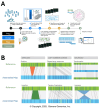Integration of Newer Genomic Technologies into Clinical Cytogenetics Laboratories
- PMID: 40565580
- PMCID: PMC12193535
- DOI: 10.3390/genes16060688
Integration of Newer Genomic Technologies into Clinical Cytogenetics Laboratories
Abstract
Over the past several decades, clinical cytogenetics has branched out from the use of light microscopy and examination of banded chromosomes to embrace multiple newer techniques, including fluorescence in situ hybridization (FISH), multiple generations of microarray designs, as well as the newest technologies, namely, optical genome mapping (OGM) and genomic proximity mapping (GPM). While these newer technologies have had an increasingly molecular genetic focus over time, they are still rooted in the field of cytogenetics, the genetics of the single cell. This review provides a brief overview of the earliest, as well as the most recent, techniques available to clinical cytogenetics laboratories for both constitutional and neoplastic testing and discusses some advantages and disadvantages of each.
Keywords: chromosomal microarray; cytogenetics; fluorescence in situ hybridization (FISH); genomic proximity mapping; optical genome mapping.
Conflict of interest statement
The author has no conflicts of interest to declare.
Figures





Similar articles
-
Cancer cytogenetics in a genomics world: Wedding the old with the new.Blood Rev. 2024 Jul;66:101209. doi: 10.1016/j.blre.2024.101209. Epub 2024 May 7. Blood Rev. 2024. PMID: 38852016 Review.
-
Thriving or Withering? Plant Molecular Cytogenetics in the First Quarter of the 21st Century.Int J Mol Sci. 2025 Jul 21;26(14):7013. doi: 10.3390/ijms26147013. Int J Mol Sci. 2025. PMID: 40725259 Free PMC article. Review.
-
A rapid and systematic review of the clinical effectiveness and cost-effectiveness of paclitaxel, docetaxel, gemcitabine and vinorelbine in non-small-cell lung cancer.Health Technol Assess. 2001;5(32):1-195. doi: 10.3310/hta5320. Health Technol Assess. 2001. PMID: 12065068
-
Diagnostic test accuracy and cost-effectiveness of tests for codeletion of chromosomal arms 1p and 19q in people with glioma.Cochrane Database Syst Rev. 2022 Mar 2;3(3):CD013387. doi: 10.1002/14651858.CD013387.pub2. Cochrane Database Syst Rev. 2022. PMID: 35233774 Free PMC article.
-
Assessing the comparative effects of interventions in COPD: a tutorial on network meta-analysis for clinicians.Respir Res. 2024 Dec 21;25(1):438. doi: 10.1186/s12931-024-03056-x. Respir Res. 2024. PMID: 39709425 Free PMC article. Review.
References
-
- Gersen S.L., Keagle M.B., editors. The Principles of Clinical Cytogenetics. 3rd ed. Springer; New York, NY, USA: 2013. - DOI
-
- Fang H., Eacker S.M., Wu Y., Neufeld–Kaiser W., Laurino M., Keel S., Horwitz M.S., Liu Y.J. Genetic and Functional Characterization of Inherited Complex Chromosomal Rearrangements in a Family with Multisystem Anomalies. Genet. Med. Open. 2025:1–39. doi: 10.1016/j.gimo.2025.103423. - DOI - PMC - PubMed
-
- Lejeune J., Gautier M., Turpin R. [Study of somatic chromosomes from 9 mongoloid children] C. R. Hebd. Seances Acad. Sci. 1959;248:1721–1722. - PubMed
-
- Nowell P.C., Hungerford D.A. Chromosome Studies on Normal and Leukemic Human Leukocytes. J. Natl. Cancer Inst. 1960;25:85–109. - PubMed
Publication types
MeSH terms
LinkOut - more resources
Full Text Sources
Miscellaneous

